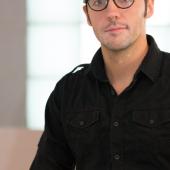It's a long way to run
It's difficult to summarize what I witnessed over the weekend at Red Eye Theater's RELAY RELAY. It was two entire days of artist interviews. This is not exaggeration: the first interview on day one started at 9:40am. The last one ended around 11pm. Red Eye's marketing described it as an "interview marathon," but I think "marathon" is still too small a word to describe this much interviewing. This was more like running three marathons in one day and then getting up the next morning to do it all over again, except with words and coffee instead of running shoes and band-aided nipples.
Being a veteran of many a weekend-long theater conference, I figured I could handle it; but I was a little confused by the lack of a theme or central question. I'm a big believer in the "limit in order to free" philosophy; it's been my experience that when people are allowed to go anywhere at all with no limitations, they usually end up going nowhere particularly interesting. I was hoping that the press release that we received here at Playlist would have more information on the unifying idea of this event, but it mostly dwelled on the form of thing:
"[T]he interview participants for RELAY RELAY have been selected through a unique 'chain curation' process: the event organizers selected the first five participants, those five picked another artist to interview, and so on."
I will admit that I was a little trepidatious about watching artists interview other artists, especially artists who had been allowed to select the other artists they would interview. It could have easily spiraled into a succession of friends diving into the impenetrable minutiae of their existing friendships. Asking meaningful questions and coaxing meaningful answers out of a interview subject is not easy, and it takes a careful, practiced professional to get to the heart of the matter without wasting copious amounts of time. It's a rare skill, and I've listened to enough rambling podcasts to know that by now.
But, believe it or not, I'm actually a very optimistic person. When I walked into the Red Eye on that sunny Saturday morning, I was thinking, "I have no idea where this is going; this could be interesting."
Still, I couldn't shake that question : "But who is this for?"
Unfortunately, it doesn't seem like many people thought it was for them. The audience was pretty sparse. Even though Red Eye provided copious amounts of good snacks and coffee and encouraged people to come and go as they pleased, the whole of the project is probably far too overwhelming for the average person, or even the average dedicated artist. Lots of people enjoy jogging; very few of them run ultramarathons.
I'm glad to say, though, that these two days of interviews mostly avoided all the problems I was prepared for. It was a series of serious artists who have put a lot of deep thought and hard work into their various crafts. Everyone was inspiring in their own way and endlessly quoteable (stick around at the end of the article for a list of great quotes), but even as I write this days later, I'm still struggling to figure out exactly what it was all about.
There was so much material coming from so many different directions that it was easy for anyone watching to pick out a theme, if they were so inclined. For example, on the first day, in the first block of interviews, I started to see a repeated pattern of talking about social class as it relates to the arts: from costume designer Trevor Bowentalking about class differences in fabric choices and cuts ("Anything we wear is political."); to actor Kimberly Richardsondescribing performing Shakespearean asides to inmates in prison ("They lean in, like 'Oh, you're choosing me!'") as apposed to performing the same things to a middle-class audience ("They lean back, like they don't want you to embarrass them."); to director Chantal Pavageauxdiscussing the destructive American fable that a lack of success and money is the result of a moral failing, even though high level success in the arts world usually requires already having plenty of money to begin with.
I noticed a lot of immigrants who actively chose to come to this country because of the opportunities and freedom it provided: Trinidadian singer and dancer Anjanie Da Artist, who badgered her mother into bringing her here as a teenager; British-born Nigerian music producer Ben Obi, who brings together musical influence from the three different continents he considers home; Akiko Ostlund, who went from Japansese transplant and stay-at-home mom to being a dancer and performance artist almost by accident; Masanari Kawahara, who came from Japan to be a "serious" actor and wound up being one of the premier puppeteers of the Twin Cities; filmmaker E.G. Bailey, the son of a Liberian woman and an American Peace Corps volunteer, whose life story is so astonishing and heartbreaking that it should itself be a movie.
To me, I was getting a microcosm picture of our country. At the same time that it is deeply riven with social, monetary and class divisions which severely undermine the philosophical foundations of the entire experiment (and which we adamantly refuse to address) we are also constantly attracting the most dedicated and innovative people from around the world who believe deeply in that foundational story of opportunity and freedom. When Akiko Ostlund was being interviewed by fellow Japansese immigrant Masanari Kawahara, she admitted, "I didn't fit in in Japan." Kawahara responded, "I think that's why we are here."
I got the message that, despite all our flaws, we are still a beacon for the oddballs and outcasts who ultimately make our nation weirder and stronger at the same time. I found it to be a powerful message.
Then later I overheard someone in the audience during a break say, "Roller skates have come up a few times. Maybe roller skates is a theme."
Any project like this is going to produce a lot of signal, and also a hell of a lot of noise. Discerning between the two, picking out the real, meaningful patterns, is going to be difficult, and may end up just being a giant Rorschach test. For my part, I just finished reading 1491and 1493and am currently knee-deep in Fantasyland: How America Went Haywire, so thoughts of class, immigration and the American mythos are forefront in my mind. Someone else probably went skating recently.
As it turns out, I didn't have that stamina to endure the full ultramarathon of RELAY RELAY. After sitting in Red Eye for the first 8 hours on Saturday, I just didn't have the will to go on all the way to 11pm. It's a lot of sitting and listening to people talk, and the occasional attempt to spice up the interviews (like refreshing the furniture setup or an interviewer making pancakes while questioning her subject) just weren't enough to keep me going through the entirety of this project.
Near the end of her interview with Masanari Kawahara, visual and performance artist Rebekah Crisanta de Ybarrabrought out a box of random things for the puppeteer to play with, wanting to see how he worked. He immediately launched in with masking tape, a party hat and some torn pieces of paper, creating a little creature that sprouted a beak, arms and long legs as he worked.. At one point, the poor thing's head fell off and Kawahara laughed. de Ybarra asked him, "Do you have a plan when you're doing this?"
Kawahara smiled and said, "No!"
Then, miraculously, the puppet he was creating grew wings and flew gracefully up from the floor. The entire audience leaned in, watched it float for a moment, and applauded as it disintegrated back into paper. That's a moment I won't forget.
RELAY RELAY is a good first stab at something that could be valuable to the performance community as a whole. If Red Eye decides to commit to this as an ongoing project with more curation and focus, it could definitely become something useful and maybe even powerful. Since they are planning on releasing a publication of the event, with edited portions of the interview and additional reflective writing they may even get to that you can (pre-order it if you're interested). I could definitely see selected recordings of the interviews going viral in a TED talk kind of way, though I doubt you would be able to experience the magic of that paper puppet flying unless you were there in person.
As it is now, the live event is a little bit surprising, a little bit messy, a little bit enlightening and way too long. But that's life in a nutshell, isn't it?
BONUS MATERIAL: great quotes from RELAY RELAY
Sonya Berlovitz, costume designer
"I never feel like it's finished, but the show does open."
"I have come to enjoy the lack of perfection."
Kimberly Richardson, actor
On the traditional writing and casting of female characters: "Beauty was valued over so many other attributes... historically, most of the funny roles were written for men... Because I'm funny, I'm kind of seen as not a woman."
Trevor Bowen, costume designer
"Most people don't leave the house thinking, 'Great! I look like shit!'"
"Anything we wear is political."
On overdesigning a show: "We undermine the audience's intelligence with all these things we put on them."
Chantal Pavageaux, writer and director
"Don't be afraid to throw something out just because you spent a lot of time and money on it... You don't have to keep riding that broken bicycle."
"Huge bulldozers have been pushing us to this moment, but we're all so small that we don't see the wheels moving."
Alan A+ Mure, dancer and choreographer
"When you're not full, you can't perform to your fullest capabilities."
"You need to allow some time for silence... sometimes you have too much noise in your life, so that you can't receive the messages you need."
Anjanie Da Artist, singer, dancer and recording artist
"When you have a vision, and it's your own vision, you can't expect everyone else to just fully get it."
"There's somebody else out in this world who doesn't even know that they can be something, and you have a responsibility to do something about that."
"If you wanna know something, find out."
Ben Obi, music producer
"To be a musician, you have to study the past, to know what came before you."
"To expect other people to be reliable, you have to be reliable first."
Akiko Ostlund, dancer and performance artist
"I always imagined I would be a craft man, like you just dig a hole in one place and that's where you stay. I don't know what happened."
On being a mother and an artist, asked, "How do you do it?": "I'm not doing it... There's a lot of balls that I drop and emails that I pretend I don't see... I just came to the realization that this is how I'm going to live."
E.G. Bailey, filmmaker
"I discovered that I could go to paper with what I was feeling, and nobody could judge it."
"The way to master a culture is to master the language."
"I realized I have to figure out this Western culture shit if I'm going to survive."
Rebekah Crisanta de Ybarra, visual and performance artist
"When something similar is placed on a white wall, suddenly it's valuable... Why is folk art, the art of the people considered not valuable?"
Masanari Kawahara, actor and puppeteer
When asked why he doesn't describe himself as a dancer: "I just can't follow the choreography, but I can move on my own terms."
"I am a part-time Buddhist."
"I don't talk. I do."




